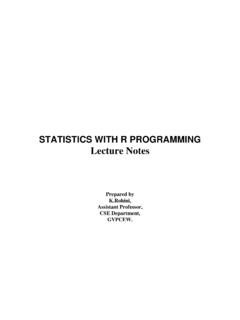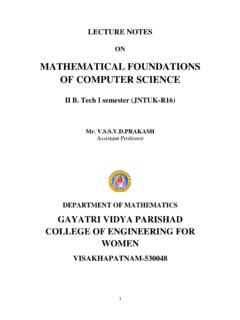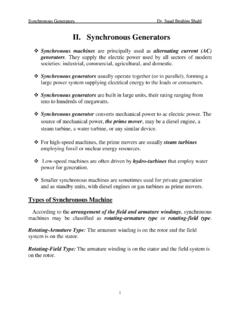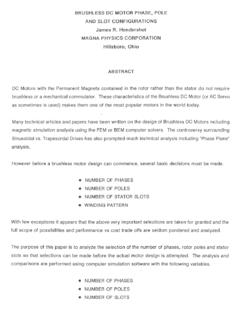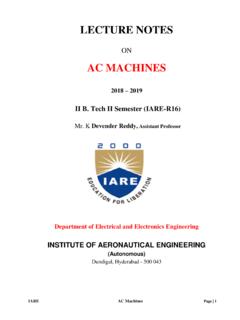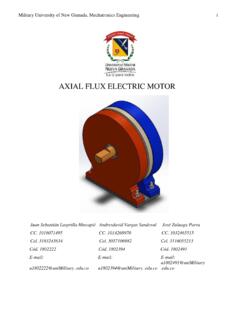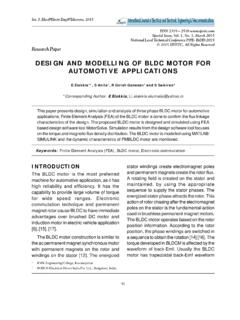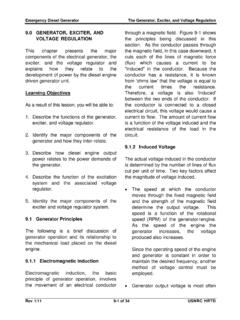Transcription of UNIT-1 SINGLE-PHASE INDUCTION MOTORS
1 UNIT-1 SINGLE-PHASE INDUCTION MOTORS INTRODUCTION: There are two basic reasons for the use of SINGLE-PHASE MOTORS rather than 3-phase MOTORS . 1. For reason of economy, most houses, offices and also rural areas are supplied with single phase , as power requirements of individual load items are rather small. 2. The economics of the motor and its branch circuit. Fixed loads requiring not more than can generally be served most economically with single phase power and a single phase motor . single phase MOTORS are simple in construction, reliable, easy to repair and comparatively cheaper in cost and therefore, find wide use in fans, refrigerators, vacuum cleaners, washing machines, other kitchen equipment, tools, blowers, centrifugal pumps, small farming appliances etc.
2 Because of above reasons MOTORS of comparatively small ratings (mostly in fractional KW ratings) are manufactured in large number to operate on single phase ac at standard frequencies. An indication of the number of such MOTORS can be had from the fact that the sum of total of all fractional kilowatt MOTORS in use today far exceeds the total of integral kilowatt MOTORS of all types. TYPES OF SINGLE-PHASE motor : The single phase MOTORS may be of the following types: 1. SINGLE-PHASE INDUCTION MOTORS : A. Split-phase MOTORS (i) Resistance-start motor (ii) Capacitor-start motor (iii) Permanent-split ( single -value) capacitor motor (iv) Two-value capacitor motor . B. Shaded-pole INDUCTION motor . C. Reluctance-start INDUCTION motor . D. Repulsion-start INDUCTION motor .
3 2. Commutator-Type, SINGLE-PHASE MOTORS : A. Repulsion motor . B. Repulsion- INDUCTION motor . C. series motor . D. Universal motor . 3. SINGLE-PHASE Synchronous MOTORS : A. Reluctance motor . B. Hysteresis motor . C. Sub-synchronous motor . SINGLE-PHASE INDUCTION MOTORS Applications and Disadvantages: Applications: single phase INDUCTION MOTORS are in very wide use in industry especially in fractional horse-power field. They are extensively used for electrical drive for low power constant speed apparatus such as machine tools, domestic apparatus and agricultural machinery in circumstances where a three-phase supply is not readily available. single phase INDUCTION MOTORS sizes vary from 1/400 kw to 1/25 kw are used in toys, hair dryers, vending machines etc.
4 Universal motor is widely used in portable tools, vacuum cleaners& kitchen equipment. Disadvantages: Though these machines are useful for small outputs, they are not used for large powers as they suffer from many disadvantages and are never used in cases where three-phase machines can be adopted. The main disadvantages of SINGLE-PHASE INDUCTION MOTORS are: 1. Their output is only 50% of the three-phase motor , for a given frame size and temperature rise. 2. They have lower power factor. 3. Lower efficiency. 4. These MOTORS do not have inherent starting torque. 5. More expensive than three-phase MOTORS of the same output. 6. Low overload capacity. CONSTRUCTION OF single PHASE INDUCTION motor : single phase INDUCTION motor is very simple and robust in construction.
5 The stator carries a distributed winding in the slots cut around the inner periphery. The stator conductors have low resistance and they are winding called Starting winding is also mounted on the stator . This winding has high resistance and its embedded deep inside the stator slots, so that they have considerable inductance. The rotor is invariably of the squirrel cage type. In practice, in order to convert temporarily the single phase motor into two-phase motor , auxiliary conductors are placed in the upper layers of stator slots. The auxiliary winding has a centrifugal switch in series with it. The function of the switch is to cut off the starting winding, when the rotor has accelerated to about 75% of its rated speed. In capacitor-start MOTORS , an electrolytic capacitor of suitable capacitance value is also incorporated in the starting winding circuit.
6 The main stator winding and auxiliary (or starting) winding are joined in parallel, and there is an arrangement by which the polarity of only the starting winding can be reversed. This is necessary for changing the direction of rotation of the rotor. Fig: A 1-phase INDUCTION motor is similar to a 3-phase squirrel cage INDUCTION motor in physical appearance. The rotor is same as that employed in 3-phase squirrel cage INDUCTION motor . There is uniform air gap between stator and rotor but no electrical connection between them. Although single phase INDUCTION motor is more simple in construction and is cheaper than a 3-phase INDUCTION motor of the same frame size, it is less efficient and it operates at lower power factor. WORKING OF SINGLE-PHASE INDUCTION motor : A single phase INDUCTION motor is inherently not self-staring can be shown easily.
7 Consider a single phase INDUCTION motor whose rotor is at rest. Let a single phase source be connected to the stator winding (it is assumed that there is no starting winding). Let the stator be wound for two poles. When power supply for the stator is switched on, an alternating current flows through the stator winding. This sets up an alternating flux . This flux crosses the air gap and links with the rotor conductors. By electromagnetic INDUCTION s are induced in the rotor conductors. Since the rotor forms a closed circuit, currents are induced in the rotor bars. Due to interaction between the rotor induced currents and the stator flux , a torque is produced. It is readily seen that if all rotor conductors in the upper half come under a stator N pole, all rotor conductors in the lower half come under a stator S pole.
8 Hence the upper half of the rotor is subjected to a torque which tends to rotate it in one direction and the lower half of the rotor is acted upon by an equal torque which tends to rotate it in the opposite direction. The two equal and opposite torques cancel out, with the result that the net driving torque is zero. Hence the rotor remains stationary. Thus the single phase motor fails to develop starting torque. This argument holds good irrespective of the number of stator poles and the polarity of the stator winding. The net torque acting on the rotor at standstill is zero. If, however, the rotor is in motion in any direction when supply for the stator is switched on, it can be shown that the rotor develops more torque in that direction. The net torque then, would have non-zero value, and under its impact the rotor would speed up in its direction.
9 The analysis of the single phase motor can be made on the basis of two theories: i. Double revolving field theory, and ii. Cross field theory. DOUBLE REVOLVING FIELD THEORY: This theory makes use of the idea that an alternating uni-axial quantity can be represented by two oppositely-rotating vectors of half magnitude. Accordingly, an alternating sinusoidal flux can be represented by two revolving fluxes, each equal to half the value of the alternating flux and each rotating synchronously ( =120 ) in opposite direction. As shown in figure: (a) let the alternating flux have a maximum value of . Its component fluxes A and B will each equal to /2 revolving in anti-clockwise and clockwise directions respectively. After some time, when A and B would have rotated through angle + and , as in figure: (b), the resultant flux would be = 2* m2 cos2 2 = m cos After a quarter cycle of rotation, fluxes A and B will be oppositely-directed as shown in figure: (c) so that the resultant flux would be zero.
10 Fig: (a) Fig: (b) (c) Fig: (d) Fig: (e) After half a cycle, fluxes A and B will have a resultant of -2* m2 = - m. After three quarters of a cycle, again the resultant is zero, as shown in figure: (e) and so on. If we plot the values of resultant flux against between limits =00 to =3600, then a curve similar to the one shown in figure: (f) is obtained. That is why an alternating flux can be looked upon as composed of two revolving fluxes, each of half the value and revolving synchronously in opposite directions. Fig: (f) It may be noted that if the slip of the rotor is S with respect to the forward rotating flux ( one which rotates in the same direction as rotor) then its slip with respect to the backward rotating flux is (2-S).
